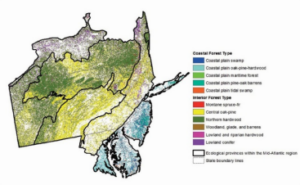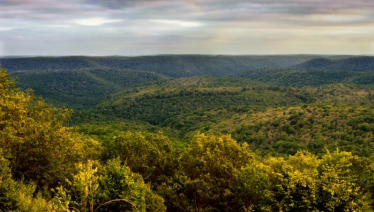More than forty scientists and forest managers collaborated to assess the vulnerability of mid-Atlantic region forests to impacts from a changing climate.(Photo: Nicholas Tonelli at Susquehannock State Forest)
The Mid-Atlantic Region Forest Ecosystem Vulnerability Assessment and Synthesisis the work of dozens of scientists and forest managers who evaluated climate change scenarios and influences on forests in Pennsylvania, New York, Delaware and parts of Maryland. Published by the USDA Forest Service, the 294 page report covers a wide range of findings and addresses implications for forest management and conservation. Among the key findings:
Temperatures will increase. Under the low climate scenario, we can expect increases of 1 to 4 °F, with some hot or cool areas. Under the high climate scenario, we can expect much warmer temperatures ranging from 4 to 10 °F or more.
Precipitation will change. Models project precipitation to generally increase in winter and spring, especially under the high climate scenario. Models disagree about the seasonal timing of increases or decreases in summer and fall. Regional studies also project more frequent heavy rain events, with evidence that extreme events will be interspersed among relatively longer dry periods.
Forest vegetation may face increased risk of physiological drought. Warmer temperatures can result in decreased soil moisture even without a decrease in precipitation, resulting in less available water for plants. Extremely hot days can increase drought-induced mortality by disrupting plant physiology.
Wildfire risk will increase. The fire season in the Mid-Atlantic region is closely linked with increases in summer temperature. National and regional studies agree that wildfire risk will increase across the region due to changes in temperature and precipitation. Fire severity may also increase as a result of dry fuels from pest-induced mortality, invasive plants, or storm damage.
Tree regeneration and recruitment will be affected by changing conditions. Predicted changes in temperature, precipitation, growing season onset, and soil moisture may alter the duration or quality of germination conditions. After establishment, saplings may still be more sensitive than mature trees to disturbances such as drought, heat stress, frost, fire, and flooding.
Suitability for northern species will decline; suitability for southern species will increase. Forest impact models project decreases in habitat suitability for northern and remnant boreal species such as black spruce, red spruce, and northern white-cedar. On the other hand, suitable habitat and biomass for tree species with ranges largely south of the region will increase, including blackgum and shagbark hickory. Habitat fragmentation or natural barriers may also hinder the northward movement of southern tree species, despite increases in habitat suitability.
Invasive plants, pests, and pathogens will increase or become more damaging.A warming climate has been linked to increased susceptibility of trees to native and nonnative pests and pathogens. These agents may also benefit from changes such as warmer, wetter springs, to increase in number and extent. Longer growing seasons, warmer winters, and increased disturbance may also benefit the growth or migration of invasive plants, such as kudzu, bush honeysuckles, and privet.
The report cites a number of management implications. Among the most direct implications for land protection: “Land conservation planning is expected to include more emphasis on climate adaptation strategies related to carbon mitigation, refugia for at-risk species and habitats, landscape connectivity for migration corridors, and water supply protection.”
A helpful four page summary of the report can be found here.

Forest communities of the Mid-Atlantic region.
(Image: Mid-Atlantic Region Forest Ecosystem Vulnerability Assessment and Synthesis)
Lightning Update is a regular communication of the Chesapeake Conservation Partnership. Any opinions expressed are those of the authors and do not necessarily reflect positions of the Partnership or member organizations.
To share a success story, news, or important event, send your information to:
Support for the Chesapeake Conservation Partnership is provided by:
National Park Service Chesapeake
EPA Chesapeake Bay Program
USDA Forest Service
Pennsylvania Department of Conservation & Natural Resources
Maryland Department of Natural Resources
Virginia Outdoors Foundation
US Fish & Wildlife Service
Chesapeake Conservancy
The Chesapeake Conservation Partnership is co-convened by:




